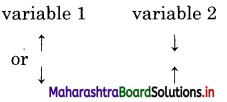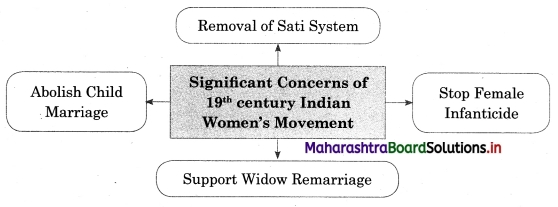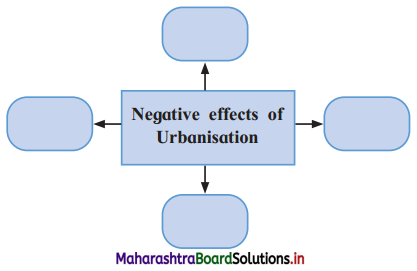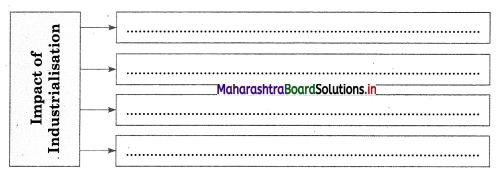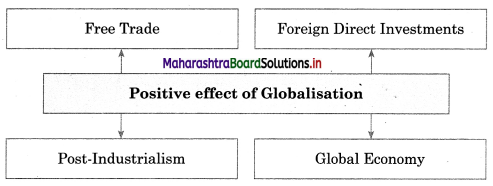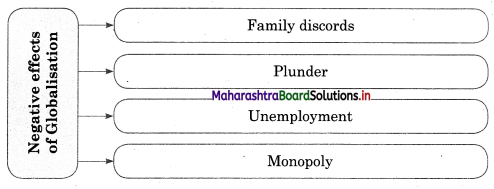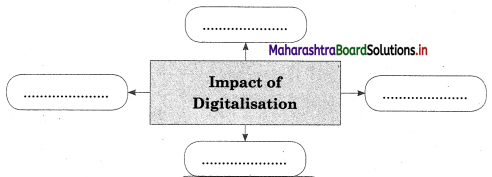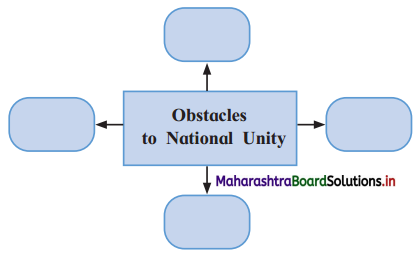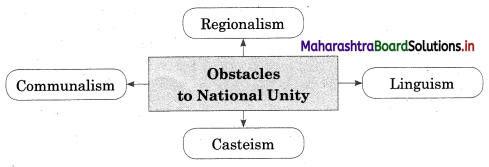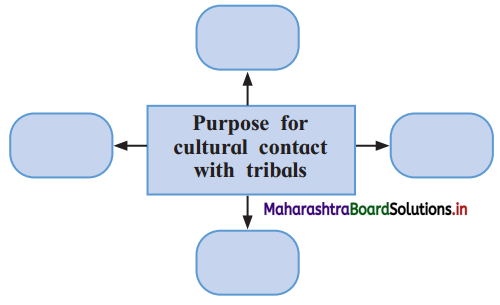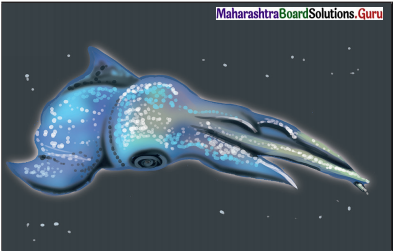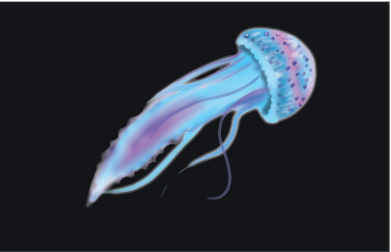Psychology Class 12 Chapter 2 Intelligence Question Answers Maharashtra Board
Balbharti Maharashtra State Board Class 12 Psychology Solutions Chapter 2 Intelligence Textbook Exercise Questions and Answers.
Intelligence Class 12 Psychology Chapter 2 Questions and Answers
1. Choose the correct option and complete the following statements.
Question 1.
……………………. has given formula of I.Q.
(a) Binet
(b) Stern
(c) Wechsler
Answer:
(b) Stern
Question 2.
…………………. has given the concepts of fluid intelligence and crystallized intelligence.
(a) Cattell
(b) Thorndike
(c) Salovey
Answer:
(a) Cattell
![]()
Question 3.
…………………. is an individual test of intelligence.
(a) Army Alpha Test
(b) Army Beta Test
(c) Block Building Test
Answer:
(c) Block Building Test
2. State whether the following statements are true or false.
Question 1.
Verbal tests of intelligence can be given easily to illiterate people.
Answer:
False
Question 2.
It is possible to increase emotional intelligence.
Answer:
True
Question 3.
There are certain limitations to Artificial Intelligence.
Answer:
True
Question 4.
Group tests of intelligence are less expensive.
Answer:
True
3. Answer the following in one sentence each.
Question 1.
What is meant by intelligence?
Answer:
David Wechsler defines intelligence as, “the aggregate or global capacity of an individual to act purposefully, to think rationally and to deal effectively with his environment.”
![]()
Question 2.
Who is considered as the father of intelligence test?
Answer:
Alfred Binet is considered as the father of intelligence tests.
Question 3.
What is meant by verbal tests of intelligence?
Answer:
Verbal tests of intelligence make use of words and numbers to measure intelligence and subjects respond verbally to the test items, for e.g., WAIS, Army Alpha Test, etc.
Question 4.
What is meant by individual test of intelligence?
Answer:
Individual tests of intelligence are tests which can be administered to a single person at a time, for e.g., Stanford Binet Scales, WAIS, Koh’s Block Design Test, etc.
4. Define / Explain the concepts in 25 – 30 words each.
Question 1.
Mental Age
Answer:
Alfred Binet introduced the concept of Mental Age. It is defined as the age at which the person successfully performs on all items of the test prepared for that age level. Mental Age need not correspond to Chronological Age. If Mental Age (MA) is the same as Chronological Age (CA), the person has average intelligence. For e.g., Sumit aged 10 years has successfully performed all items on the test for age 12. Hence, his Mental Age will be 12 years, i.e., he has above average intelligence.
Question 2.
Social Intelligence
Answer:
E.L. Thorndike proposed the term Social Intelligence. Howard Gardner included ‘interpersonal intelligence’in the Multiple Intelligences Theory. According to Karl Albrecht, ‘Social intelligence . is the ability to get along well with others and to get them to cooperate with oneself.’
A continued pattern of nourishing behaviour indicates a high level of social intelligence. Such persons are skilled at interacting with and understanding people around them. They respect and encourage others. They effectively comprehend social dynamics.
![]()
Question 3.
Emotional Intelligence
Answer:
The term Emotional Intelligence was used for the first time by John Mayer and Peter Salovey. The concept of emotional intelligence was popularized by Daniel Goleman. It is defined as “the ability to perceive and monitor one’s own and others emotions, to discriminate among them and to use this information to guide one’s thinking and actions.” Emotional Intelligence refers to a set of cognitive abilities such as perceiving emotions, using emotions to facilitate thought, understanding emotions and managing (regulating) emotions. Persons with high emotional intelligence tend to be emotionally stable, patient, optimistic, enthusiastic and calm.
5. Write short notes on the following.
Question 1.
Intelligence Quotient
Answer:
Intelligence is the highest attribute of human beings. Different psychologists have defined intelligence differently. Lewis Terman explains intelligence as, “an ability to think on an abstract level.”
David Wechsler defines intelligence as, “the aggregate or global capacity of an individual to act purposefully, to think rationally and to deal effectively with his environment.”
Intelligence Quotient refers to a measurement of intelligence.. In 1912, William Stern introduced the concept of intelligence quotient (IQ). Terman, refined the formula for calculating IQ, which is as stated below-
IQ = \(\frac {MA}{CA}\) × 100
Example: Ankush who is 10 years old has a Mental Age of 11 years. Let us calculate his IQ.
MA = 11 years CA = 10 years IQ = ?
IQ = \(\frac {MA}{CA}\) × 100 = \(\frac {11}{10}\) × 100 = 110
Ankush has an IQ of 110.
Question 2.
Charles Spearman’s theory of intelligence
Answer:
Intelligence is the highest attribute of human beings. Different psychologists have defined intelligence differently. Lewis Terman explains intelligence as, “an ability to think on an abstract level.”
David Wechsler defines intelligence as, “the aggregate or global capacity of an individual to act purposefully, to think rationally and to deal effectively with his environment.”
In 1927, Charles Spearman with the help of a statistical method called factor analysis separated and identified two different factors of intelligence viz. General factor (g) and Specific factor (s).
- General factor is the minimum competence required to carry out daily work.
- Specific factor includes abilities which are required to solve problems in specific areas.
![]()
Question 3.
Verbal tests of intelligence
Answer:
Intelligence is the highest attribute of human beings. Different psychologists have defined intelligence differently. Lewis Terman explains intelligence as, “an ability to think on an abstract level.”
David Wechsler defines intelligence as, “the aggregate or global capacity of an individual to act purposefully, to think rationally and to deal effectively with his environment.”
On the basis of material used in the tests, intelligence tests can be classified as Verbal tests and Non-verbal tests of intelligence. Intelligence tests that use language (words or numbers) for measuring intelligence are called verbal tests of intelligence. In these tests subjects are required to respond verbally to test items. Army Alpha Test, Wechsler’s Adult Intelligence Scale (WAIS), etc., are some of the examples of verbal tests of intelligence. These tests are language and culture bound and hence cannot be used with children, illiterates etc. However, they are useful in measuring higher mental abilities.
Question 4.
Non-verbal tests of intelligence
Answer:
Intelligence is the highest attribute of human beings. Different psychologists have defined intelligence differently. Lewis Terman explains intelligence as, “an ability to think on an abstract level.”
David Wechsler defines intelligence as, “the aggregate or global capacity of an individual to act purposefully, to think rationally and to deal effectively with his environment.”
On the basis of material used in the tests, intelligence tests can be classified as Verbal tests and Non-verbal tests of intelligence.
Intelligence tests that use pictures, designs, material objects, etc., to measure intelligence are called non-verbal tests of intelligence. In these tests language is not used to measure intelligence. In these tests subjects are not required to respond verbally to test items. Non-verbal tests are of two types viz.
- Performance tests for e.g., Koh’s Block Design test, Dr. Bhatia’s Non Verbal test, Alexander’s Pass-along test, etc. and
- Paper-pencil tests for e.g., Raven’s Standard Progressive Matrices.
Question 5.
Artificial Intelligence
Answer:
The term Artificial Intelligence was suggested by John McCarthy. Artificial intelligence is an innovation created by human intelligence. It is a field of study that combines computer science, algorithms, psychology, etc. It refers to enabling software programmes and computer systems to perform tasks that normally require human intelligence, such as visual perception, speech recognition, weather forecasting, language translation, etc.
Artificial intelligence can take decisions only on the basis of stored information and so cannot be an alternative to human intelligence. Artificial intelligence has immense applications in daily life as well as to solve critical problems. Artificial intelligence is used in devices like robots, computers, self-driving cars, automatic missiles, smart phones, medical diagnostic tools, etc.
6. Answer the following questions with the help of the given points.
Question 1.
Write in brief about individual tests of intelligence
(i) Meaning
(ii) Advantages
(iii) Disadvantages
Answer:

(i) Meaning – Intelligence tests that can be administered to a single person at a time are called individual tests of intelligence, for e.g., Stanford Binet Scales, Koh’s Block Design Test, etc.
(ii) Advantages-
- The test administrator can establish a rapport with the client.
- The test administrator can get additional information about the client’s feelings, moods and expressions during testing.
- Individual tests are more capable of measuring creative thinking, compared to group tests.
(iii) Disadvantages-
- Individual tests are time consuming and costly to administer.
- Individual tests require a trained and skillful examiner to administer, score and interpret them.
- These tests cannot be used for mass testing.
![]()
Question 2.
Write in brief about group tests of intelligence
(i) Meaning
(ii) Advantages
(iii) Disadvantages
Answer:

(i) Meaning – Group test of intelligence are tests that can be administered to more than one person at a time, i.e., for mass testing, for e.g., Army Alpha and Army Beta Test, OTIS self¬administrating tests, etc.
(ii) Advantages-
- Group tests are less time consuming and more economical to administer.
- In administrating of group tests, the role of the examiner is minimal. So, he/she need not go through any specialised training.
- These tests can be used in cases where mass testing is needed.
(iii) Disadvantages-
- The test administrator has much less opportunity to establish rapport, obtain cooperation and maintain interest of the clients.
- Compared to individual tests, group tests are less capable of measuring the creative aspect of intelligence.
7. Answer the following questions in Detail.
Question 1.
Write in detail about the history of intelligence testing.
Answer:
Intelligence is the highest attribute of human beings. Different psychologists have defined intelligence differently. Lewis Terman explains intelligence as, “an ability to think on an abstract level.”
David Wechsler defines intelligence as, ‘the aggregate or global capacity of an individual to act purposefully, to think rationally and to deal effectively with his environment’. Many psychologists have contributed to the measurement of Intelligence.
Sir Francis Galton thought that he could determine intelligence by measuring the size of the human skull. He administered a battery of tests to measure variables such as head size, reaction time, visual acuity, etc. However, these tests did not prove useful to measure intelligence.
Raymond Cattell, used the term ‘mental test’ for the first time. Like his mentor, Sir Galton, Cattell also believed that intelligence is best measured by sensory tasks. However, be emphasized that test administration must be standardized.
In 1905, Alfied Binet in collaboration with Theodor Simon, published the First Scale of Intelligence. This scale was revised in 1908 and 1911. In 1916, Lewis Terman revised the scale, i.e., adapted few items, established new age norms etc. This came to be called ‘Stanford Binet Test’. Binet also introduced the concept of Mental Age. It is defined as the age at which the person successfully performs on all items of the test prepared for that age level.
In 1917, Robert Yerkes and his colleagues developed the Army Alpha (verbal test) and Army Beta (performance test) intelligence tests. These two tests were used to recruit soldiers. In 1939, during World War II also, to recruit army personnel, the Army General Classification Test was used.
In 1939, David Wechsler published the Wechsler-Bellevue Intelligence Test. In 1955, the test was revised and then called Wechsler Adult Intelligence Scale (WAIS). It has a verbal scale and performance scale. Wechsler also developed a test to measure intelligence of children, i.e., Wechsler Intelligence Scale for Children (WISC).
Mental Age – Alfred Binet introduced the concept of Mental Age. It is defined as the age at which the person successfully performs on all items of the test prepared for that age level. Mental Age need not correspond to Chronological Age. It Mental Age (MA) is the same as Chronological Age (CA), the person has average intelligence.
Intelligence Quotient – In 1912, William Stern introduced the concept of Intelligence Quotient (IQ). Terman, refined the formula for calculating IQ which is as stated below-
IQ = \(\frac {MA}{CA}\) × 100 IQ made it possible to compare the intelligence of individuals of different age CA groups.
![]()
Question 2.
‘Intelligence testing has a wide usage in various areas’. Justify with examples.
Answer:
David Wechsler defines intelligence as, ‘the aggregate or global capacity of an individual to act purposefully, to think rationally and to deal effectively with his environment.’
Types of Intelligence Tests-
(i) Individual tests of intelligence-
Individual tests of intelligence are tests which can be administered to a single person at a time, for e.g., Stanford Binet Scales, WAIS, Koh’s Block Design Test, etc.
(ii) Group tests of intelligence-
Group test of intelligence are tests that can be administered to more than one person at a time, i.e., for mass testing, for e.g., Army Alpha and Army Beta Test, OTIS self-administrating tests, etc.
(iii) Verbal tests of intelligence-
Verbal tests of intelligence make use of words and numbers to measure intelligence and subjects respond verbally to the test items, for e.g., WAIS, Army Alpha Test, etc.
(vi) Non-verbal tests of intelligence-
Non-verbal tests of intelligence do not use language to measure intelligence. They make use of pictures, designs, objects, etc. Such tests may be (i) Performance tests, e.g., Koh’s Block Design Test or (ii) Paper-pencil test e.g., Raven’s Standard Progressive Matrices.
Application of Intelligence Testing
- Effective Schooling – On the basis of intelligence test scores, teachers can classify students into intellectual categories and devise special instructional programmes suited to their mental development.
- Aids Mental Health Personnel – Intelligence tests are helpful to Mental Health personnel such as psychologists, etc., for diagnosis purposes and therapy.
- Effective Parenting – Parents can provide appropriate educational facilities to their children based on their IQ scores.
- Career Counselling – Scores obtained on intelligence tests help the student to select the right educational options/ courses.
- Vocational Counselling – Individuals can choose a suitable career and achieve job satisfaction when they make a realistic choice of vocation based on IQ scores.
Question 3.
Explain the characteristics of people having high social intelligence.
Answer:
E.L. Thorndike proposed the term Social Intelligence. Howard Gardner included ‘interpersonal intelligence’ in the Multiple Intelligences Theory. According to Karl Albrecht, “Social intelligence is the ability to get along well with others and to get them to cooperate with oneself’.
According to Karl Albrecht our behaviour towards others falls somewhere on a spectrum between toxic behaviour and nourishing behaviour. Devaluing others, refusing cooperation to others, negative talking, discouraging others, etc., are some of the examples of toxic behaviours. A continued pattern of toxic behaviour indicates a low level of social intelligence. Respecting others, cooperating with others, positive talking, encouraging others, etc., are some of the examples of nourishing behaviour. A continued pattern of nourishing behaviour indicates a high level of social intelligence.
The following are some of the characteristics of people having high social intelligence:
- They are good at understanding and interacting with other people.
- They have ability to monitor their verbal and non-verbal expressions while communicating with others.
- They are good speakers and good listeners.
- They are skilled at assessing the emotions, motivations, desires, and intentions of those around them.
- They understand social dynamics in an effective way.
- They are flexible in their approach while dealing with others.
- They are goal orientated, persistent and self- confident.
- They can resolve conflicts in social contexts.
- They are successful negotiators.
- They enhance personal and professional relationships with others.
![]()
Class 12 Psychology Chapter 2 Intelligence Intext Questions and Answers
ACTIVITY (Textbook Page. No. 12)
Activity 1
Read the following sentences and decide whether the given sentences are the facts or just beliefs about intelligence :
(i) Intelligence is something that is inborn.
(ii) Students who are intelligent can get good marks in examinations.
(iii) Students who do not get good marks in examinations are less intelligent.
(iv) People who are intelligent are very smart.
(v) Intelligent people can impress anyone by their talk.
Answer:
[All the statements are just beliefs, not facts.]
Activity 2 (Textbook Page. No. 15)
Read the following examples. Using the formula, calculate the I.Q. of the following students:
(i) Aabha is a genius girl. Her chronological age is 8 years and her mental age is 14 years. Find out her I.Q.
(ii) Mayur has learning disabilities. His chronological age is 8 years and his mental age is 6 years. Find out his I.Q.
Answer:
(i) In case of Aabha – Mental Age (MA) = 14 years
Chronological Age (CA) = 8 years, IQ = ?
IQ = \(\frac {MA}{CA}\) × 100 = \(\frac {14}{10}\) × 100 = 175
IQ = 175.
(ii) In case of Mayur – Mental Age (MA) = 6 years.
Chronological Age (CA) = 8 years, IQ = ?
MA 6
IQ = \(\frac {MA}{CA}\) × 100 = \(\frac {6}{10}\) × 100 = 75
IQ = 75.
Activity 3 (Textbook Page. No. 16)
Make a chart listing the advantages and disadvantages of individual tests of intelligence.
Answer:
(i) Advantages-
- The test administrator can establish a rapport with the client.
- The test administrator can get additional information about the client’s feelings, moods and expressions during testing.
- Individual tests are more capable of measuring creative thinking, compared to group tests.
(ii) Disadvantages-
- Individual tests are time consuming and costly to administer.
- Individual tests require a trained and skillful examiner to administer, score and interpret them.
- These tests cannot be used for mass testing.
![]()
Activity 4 (Textbook Page. No. 16)
Make a chart listing the advantages and disadvantages of group tests of intelligence.
Answer:
(i) Advantages-
- Group tests are less time consuming and economical to administer.
- In administrating group tests, the role of the examiner is minimal. So, he/she need not go through any specialized training.
- These tests can be used in cases where mass testing is needed.
(ii) Disadvantages-
- The test administrator has much less opportunity to establish rapport, obtain cooperation and maintain interest of the clients.
- Compared to individual tests, group tests are less capable of measuring creative aspect of intelligence.
Activity 5 (Textbook Page. No. 17)
Verbal test of intelligence Choose the correct option:
(i) Shoe – Foot : : Hat – ……………..
(a) Kitten
(b) Head
(c) Knife
Answer:
Shoe – Foot: : Hat – Head
(ii) Eye – Head : : Window – ………………
(a) Key
(b) Floor
(c) Room
Answer:
Eye – Head : : Window – Room
Activity 6 (Textbook Page. No. 19)
Read the examples given in Activity 6 on textbook page no. 18 and decide the positions of Chetan, Sagar and Anil on the following spectrum of behaviour:

Answer:

Activity 7 (Textbook Page. No. 20)
Study the differences between the characteristics of people having high emotional intelligence and low emotional intelligence and think about what you can do to develop your emotional intelligence?
| Characteristics of people having high emotional intelligence | Characteristics of people having low emotional intelligence |
| Emotionally stable, Patient | Emotionally unstable, Impatient |
| Optimistic, Independent | Pessimistic, Dependent |
| Happy, Enthusiastic | Sad, Apathetic |
| Calm, Satisfied | Restless, Dissatisfied |
Answer:
I will try to develop emotional intelligence by adopting the following ways-
- active listening skills .and effective style of communication.
- practice self-evaluation and self-awareness.
- respond instead of reacting in conflict situations.
- stay motivated, rational and have a positive outlook.
- show empathy, be approachable.
- adopt effective stress management techniques.
![]()
Activity 8 (Textbook Page. No. 20)
Discuss how the following devices use Artificial Intelligence:
(i) Computers
(ii) Self-driving cars
(iii) Robots
(iv) Medical diagnostic tools
(v) Translation devices
(vi) Automatic Missiles
(vii) Chatbots, etc.
Answer:
(i) Computers – AI is the ability of a computer programme to think and learn. It makes computers smart, i.e., work without being encoded with commands.
(ii) Self-driving cars – Autonomous driving is a key application of AI. Self-driving cars are equipped with multiple sensors such as cameras, radars, etc., which generate massive amount of data and simulate human perceptual and decision making processes in driving.
(iii) Robots – AI gives robots the computer vision to navigate, sense and calculate their reaction accordingly. Robots learn to perform tasks from humans through machine learning which is a part of computer programming and AI.
(iv) Medical diagnostic tools – Abnormalities in body fluids and tissue can be automatically detected using AI in medical diagnosis solutions. AI can help to speed up process of diagnosis, i.e., biomarkers.
(v) Translation devices-AI uses Neural Machine Translation (NMT), i.e., an electronic, neural network trained to recognize patterns in the input data set and translate it into desired output data, for e.g., a sentence in Japanese into English. It is more accurate than simple machine translation.
(vi) Automatic Missiles – AI is leading the world towards a battlefield that has no boundaries, may not even have humans involved and will be impossible to control across the human ecosystem in Cyberspace, Geospace and Space (CGS). It refers to the weaponisation of AI, i.e., a weapon system that can select human/ non-human targets without further intervention by a human operator.
(vii) Chatbots – AI makes it possible for chatbots to ‘learn’ by discovering patterns in data. A chatbot is a computer programme that imitates spoken and written conversation, i.e., voice commands and texts, for e.g., Siri.
Class 12 Psychology Textbook Solutions Digest
- Psychology: A Scientific Discipline Class 12 Psychology
- Intelligence Class 12 Psychology
- Personality Class 12 Psychology
- Cognitive Processes Class 12 Psychology
- Emotions Class 12 Psychology
- Psychological Disorders Class 12 Psychology
- First Aid in Mental Health Class 12 Psychology
- Positive Psychology Class 12 Psychology

